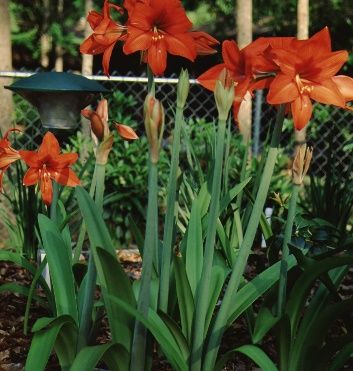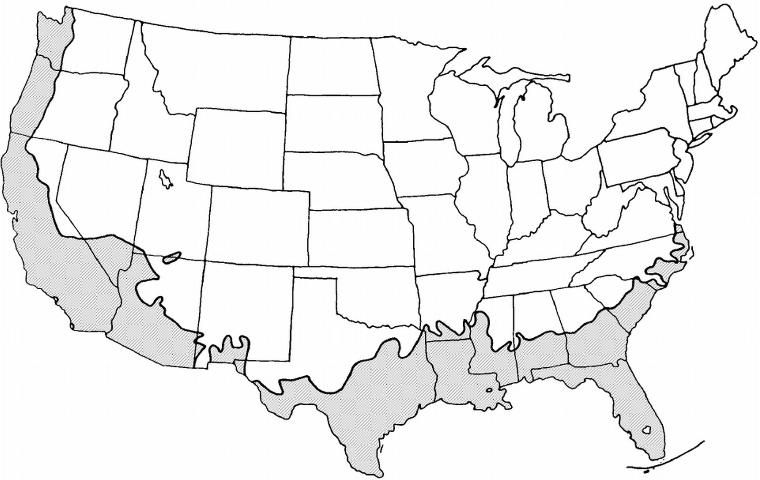Introduction
The large, bold flowers of amaryllis are well known as potted plants, the tall flower scape projecting well above the long, evergreen, strap-like leaves. Borne in clusters of two to five, the trumpet-shaped blooms appear in spring when planted in the landscape and are available in various shades and combinations of white, pink, red, or orange. Amaryllis are semi-evergreen when grown in northern Florida since the foliage lays down and rots during the winter. They can be used in a mass planting spaced about 12 inches apart or scattered among small shrubs or groundcovers for a splash of delightful spring color.

Credit: Edward F. Gilman, UF/IFAS

Credit: Edward F. Gilman, UF/IFAS
General Information
Scientific name: Hippeastrum x hybridum
Pronunciation: hip-ee-ASS-strum HYE-brid-um
Common name(s): amaryllis
Family: Amaryllidaceae
Plant type: bulb/tuber; perennial; herbaceous
USDA hardiness zones: 8 through 10 (Figure 3)
Planting month for zone 8: year round
Planting month for zone 9: year round
Planting month for zone 10 and 11: year round
Origin: not native to North America
Invasive potential: not known to be invasive
Uses: mass planting; container or above-ground planter; border; naturalizing; edging
Availability: somewhat available, may have to go out of the region to find the plant

Credit:
Description
Height: 1 to 2 feet
Spread: 1 to 2 feet
Plant habit: upright
Plant density: open
Growth rate: slow
Texture: coarse
Foliage
Leaf arrangement: most emerge from the soil, usually without a stem
Leaf type: simple
Leaf margin: entire
Leaf shape: linear
Leaf venation: parallel
Leaf type and persistence: evergreen
Leaf blade length: 18 to 36 inches
Leaf color: green
Fall color: no fall color change
Fall characteristic: not showy
Flower
Flower color: orange; pink; red; white
Flower characteristic: spring flowering
Fruit
Fruit shape: round
Fruit length: 0.5 to 1 inch
Fruit cover: fleshy
Fruit color: green
Fruit characteristic: inconspicuous and not showy
Trunk and Branches
Trunk/bark/branches: not applicable
Current year stem/twig color: not applicable
Current year stem/twig thickness: not applicable
Culture
Light requirement: plant grows in part shade/part sun
Soil tolerances: clay; sand; acidic; loam
Drought tolerance: moderate
Soil salt tolerances: poor
Plant spacing: 6 to 12 inches
Other
Roots: not applicable
Winter interest: no special winter interest
Outstanding plant: plant has outstanding ornamental features and could be planted more
Pest resistance: long-term health usually not affected by pests
Use and Management
Amaryllis will grow in any well-drained soil, preferably in high, shifting shade. They grow well under the shade of trees provided they receive some direct light for a portion of the day. They flower poorly in total shade. The foliage will discolor when plants are grown in full sun, although they will flower better. They flower poorly in shade. While the normally tough leaves will be damaged by frost in zones 8, 9, and 10, they are quickly replaced in spring. The large bulbs are normally left in the ground, but some growers prefer to lift and separate new off shoot bulblets from the bulbs each fall, replanting at biweekly intervals from November to February to provide a succession of spring bloom. Bulbs should be planted only deep enough to cover the top of the bulbs. Plants should be fertilized lightly throughout the flowering period.
The vast number of available hybrids are too numerous to list. They have been selected for flower color, number and size, sturdiness of flower stalk (scape), and plant size.
Propagation of amaryllis is by seed or division. Plants will grow quickly and easily from seed, requiring three to several years before flowering.
Pests and Diseases
Relatively pest-free, amaryllis is occasionally bothered by caterpillars and other chewing insects, neither requiring control in most instances. Soil nematodes can also slow growth.
Red blotch virus mosaic and botrytis are problem diseases.